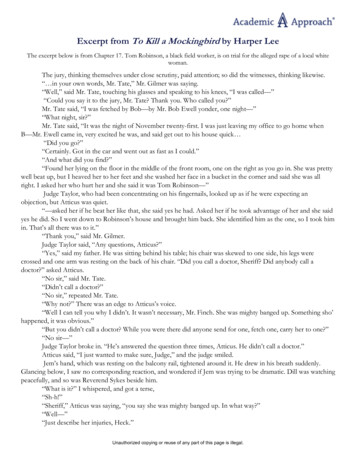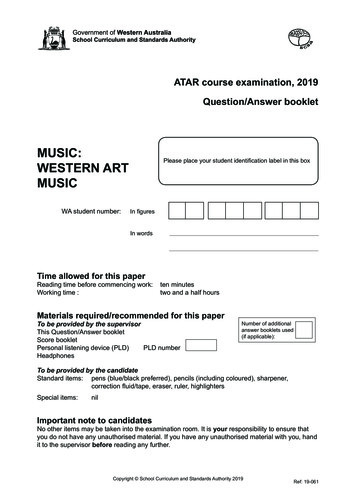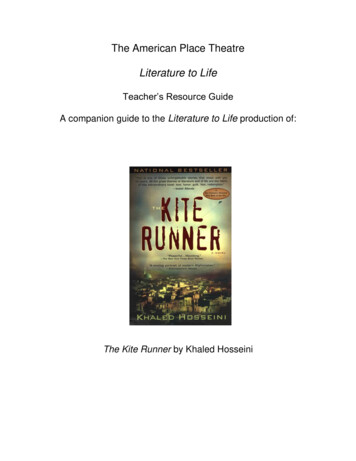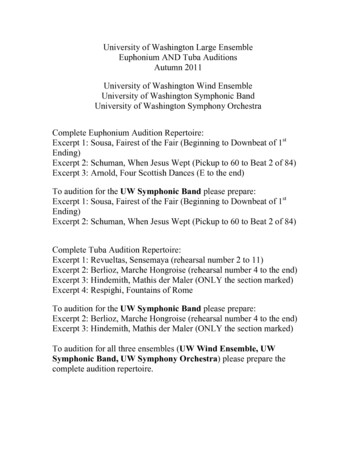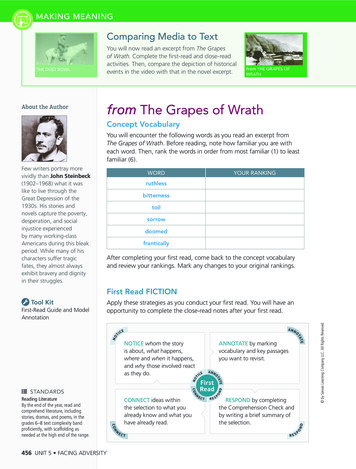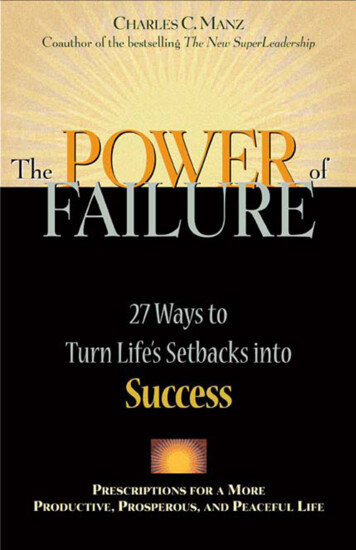
Transcription
An Excerpt FromThe Power of Failure:27 Ways to Turn Life’s Setbacks into Successby Charles C. ManzPublished by Berrett-Koehler Publishers
ContentsPrefaceixIntroduction:Succeeding with the Power of FailurePart OneRedefining Failure and Success111. To Succeed More, Fail More2. Be a Successful Learner by Learning from3.4.5.6.7.FailuresRecognize Failure as the Lifeblood of SuccessLearn the Challenging Secret to SuccessfulFailure . . . PatienceOvercome the Success Catch-22In the Face of Failure, Search forOpportunities, Not ObstaclesTo Be a Real Success, You Must FailPart TwoWinning Through Losing8.9.10.11.11317212529333741Sometimes When You Win, You LoseSometimes When You Lose, You WinSucceed at Win/Win, Not Win/LoseSucceed at Being a “Tryer” Even WhenYou’re a “Failure”12. Help Others Win, Even at Your OwnExpense, to Help Yourself13. Lose a Disagreement to Build a Relationship14. When You Feel That You’re “Losing It,”Declare “Temporary Sanity”43475155596367
viiiContentsPart ThreeCoping with Failure7315. Accept When Failure Is Really Failure16. Choose to Be Happy Over Being Right17. Use EQ to Cooperate with Failure . . .18.19.20.21.To SucceedLet Mental Storms Blow ThroughUse Failure to Master YourselfDiscover Success at the Point ofMaximum PessimismBoth Beauty and Ugliness Are in theEye of the BeholderPart FourCollaborating with Failure8389939710110522.23.24.25.Fail Small to Succeed BigSee the Magnificent in the MinimalSucceed at Living in the Present MomentContinually Invest for Success . . .Even in the Face of Failure26. Sometimes Choose to Get inOver Your Head to Get Ahead27. When You Feel Lost and Demoralizedby Your Life Path . . . Blaze a New OneGetting Started:The Power of Failure MottoNotes 137Index 141The Author 1477579133107111115119123129
IntroductionSucceeding with thePower of FailureOnly he who does nothing makes no mistakes.—French Proverb1Would you like to be successful throughoutthe remainder of your life? Would you liketo enjoy meaningful success where youlearn, grow, and contribute in significant ways;where your life is full, counts for something, andmakes a difference? If your answer is “yes,” then youmust fail. There is no exception to this rule.Significant success requires failure, but failure must beregarded in a whole new light. That is what this bookis about—how to use the Power of Failure to Succeed.Failure is one of the most dreaded words in theEnglish language. The very idea of failing is enoughto stop most people in their tracks. It can cause the1
2The Power of Failuremajority to simply pack up, turn around, and retreatwithout even trying.Success, on the other hand, is nearly a magicalidea for most people. The possibility of succeeding orbecoming a “success” is an almost mythical pursuit.People love to be labeled a success and will often sacrifice greatly to achieve this end.Although most people hate to be labeled a failure and love to be labeled a success, it is onlythrough seeming failure that most of life’s greatestsuccesses are achieved. Usually, “failure” or “success”is almost entirely in the eye of the beholder.As an example, who can forget the classic children’s story The Ugly Duckling by Hans ChristianAndersen? One of the birds in a community of ducksis singled out for constant ridicule because he is sodifferent from the rest. He is treated as an utter failure and comes to view himself as exactly that.Consequently, he loses his sense of hope, falls intodespair, and runs away from his troubles.Eventually the Ugly Duckling learns that his difference is not the curse that he thought it was. Infact, when he finally sees his own reflection in apond and discovers that he is a magnificent swan, hisapparent failure in life is completely transformed.This story may reflect an essential truth aboutwhat we call “failure.” It is very often a misperception about the difference between what exists andgoes unnoticed (such as growth and learning when
Introduction: Succeeding with the Power of Failure3we fall short of reaching a goal) and what is realizedlater (longer term success).Of course, sometimes failure is tied to a lack ofcompetence to perform in the face of a specific challenge, but seeming failures can be a powerful way tolearn and ironically provide the means for life’s greatest breakthroughs and successes. Eventually we canlearn to accept that what most people call failures areusually only temporary setbacks in relation to somearbitrary standard and are an essential part of life.They are usually just challenges in progress. This important lesson can help us understand that the onlyreal failures occur when we back away from worthwhile challenges without even trying or when we refuse to learn from our setbacks.Changing our perspective is often the key tofinding success in seeming failure. Optimistic thinking has sometimes gotten a bad rap as being unrealistic, but research has found that we can indeed livehappier, healthier, and more successful lives if we canlearn to discover the opportunities in problems.These problems then become merely challenging opportunities that we can turn to our advantage. Theyprovide opportunities for personal growth and canstimulate our creativity for finding better ways tolive.In the end, the Ugly Duckling makes this kind ofdiscovery and is magnificently transformed. Then heis able to take flight as the beautiful swan that he is3
4The Power of Failureand soar high above the ducks that had treated himwith such disdain. We too can more fully live as themagnificent beings that we are if we can come to seethat: Challenges are disguised opportunities Differences are a gift Mistakes are learning opportunities When we try our best and are willing to learn,we always succeed, even if we don’t achieve theresults we hoped for.This book is designed to provide simple yet profound ways to turn seeming failures into successes. Itcontains practical prescriptions for successfully meeting some of life’s most common setbacks. The lessons of this book are organized into four parts. Theyinclude redefining success and failure, winningthrough losing, coping with failure, and collaborating with failure. It will become obvious that thesefour parts, while distinct, are also highly related andthat the lessons contained in each significantly overlap. Nevertheless, it is useful to consider the variousprescriptions that this book has to offer across thesefour key areas for turning failure into success.It is also helpful to think of the various specificlessons of this book in relation to a larger whole—more general guidelines for failing successfully. Most
Introduction: Succeeding with the Power of Failure5of the book’s prescriptions relate to some primarythemes, which are summarized in the following list.We can think of these themes as a new view or visionof how we can transform failure so that it contributespositively to more successful living.A New View of Failure: Some Primary Themes1. Redefine Failure. Failure is a natural part of lifethat can impact us positively or negatively depending on how we define it.2. Redefine Success. The more important measureof success is based on our own deeper knowingof what’s right for us rather than approval or disapproval from others.3. Learn from Failure. Failure presents an opportunity for continued learning and growth whilesuccess can lead to complacency and stagnation.4. View Failures as Stepping-Stones to Success.Success and failure are not incompatible—mostfailures are simply challenges in progress that canprovide a foundation for success.5. Find the Opportunities of Failure. Setbacks orshort-term failures can contribute to future success if we focus on the opportunities they contain rather than the obstacles.6. Use Negative Feedback to Your Advantage.Current negative feedback can provide positive5
6The Power of Failureinformation for improvement or may even suggest that you are onto something new and different—a sign of a pending breakthroughsuccess.7. Look Beyond Yourself. As you learn to focusoutward, on helping others succeed rather thanyourself, you become less vulnerable to whatotherwise might appear to be personal failures.8. Persist. Keep on trying and trying.Sustained Effort the Lessons of Failuresis a powerful formula for success.One other point should be made at the outset.This book is not advocating failure as end in itself.Rather, failure is a means, an essential ingredient, tosuccessful living. The value of failure is in the learning and growth that it provides. Without learningand growth, failure can be a destructive force in ourlives. In that sense this book is really about effectivesuccess, not success that leads to an inflated selfimage and complacency, but rather success as a wayof living that benefits from all life has to offer. Andthat includes successful learning in the face of setbacks and what some mislabel as failure.The lessons of this book can help us find the opportunities that are just waiting to be discovered inthe challenges and “failures” we face every day. Theyoffer prescriptions for a more productive, prosperous, and
Introduction: Succeeding with the Power of Failure7peaceful life. This book is about failure, but failureseen in a whole new light. It is about how we canharness the Power of Failure to help us succeed.To help get this process started, old and new definitions of failure and success follow. I hope that bythe end of this book the new definitions of successand failure will become a natural part of your perspective of life.7
FailureOld DefinitionA negative, fatal, and final resultindicating: An inability to perform and a lack ofsuccess A falling short because of ineptness,deficiency, or negligence A bad, bad thing that should beavoided, mourned, and punished.New DefinitionA short-term unexpected result thatreflects a challenge in progress and thatprovides: A stepping-stone to success An opportunity for learning and development An opportunity for creative changeand innovation.
SuccessOld DefinitionA revered shrine of achievement.An all-positive final result indicating: Superior ability that requires nofurther learning or change Performance that is devoid of flaws,weakness, or failure A good, good thing that should besought, celebrated, and honoredabove all else.New DefinitionA way of living founded on benefitingfrom all life has to offer that is: A long-term sequence of lifeimproving results An outcome of short-term setbacksand failures A process of continual development,learning, and fulfillment in life.9
If you can dream —and not make dreams your master;If you can think —and not make thought your aim;If you can meet withTriumph and DisasterAnd treat those two impostorsjust the same . . .—From “If” by Rudyard Kipling
PartOneRedefining Failureand SuccessFailure is not something to be feared. Itcontains a positive challenge for successful living. Today’s failures contain theseeds of tomorrow’s greatest successes.The first step to mastering the art of failing successfully is to come to see failureand success in a whole new light.
1To Succeed More,Fail MoreFailure is the foundation of success,and the means by which it is achieved.—Lao Tzu2An aspiring young man once asked a very prominent CEO how he could become more successful. The CEO was Tom Watson of IBM, whoreportedly responded that if the young man wantedto become more successful he should do the seemingly unthinkable—fail. In fact, Watson advised thathe should double his failure rate. At first glance this isan odd prescription indeed. Upon closer inspection,however, it contains a great deal of wisdom.A failure should not be viewed as the end ofthe story but instead as a stepping-stone to a largersuccess. If someone never fails, this is a telltale signthat he is not trying anything new or challenging.Mastering new skills and growing as individuals13
14The Power of Failurerequire that we enter unfamiliar arenas that canprovide us with new knowledge and capabilities.These new ventures can be as varied as learning toplay the piano, speak a foreign language, water-ski,or invest in the stock market.The principle remains the same—you must experience failure in order to succeed. If you expect tolearn without making a mistake, you are in for anunpleasant surprise. Imagine Mozart or Beethoventrying to compose music so cautiously that theynever hit a wrong note. Do you think they wouldhave been able to compose masterpieces if they totally avoided mistakes?In fact, Beethoven was no stranger to failure. Atone stage in his music career a music teacher saidthat he had no talent for music. The teacher even remarked that “as a composer he is hopeless.”The more you try to grow your knowledge andexperience in new and challenging areas, the moremistakes you will have to make. Much of this potential for growth boils down to being willing to takerisks. Author Carole Hyatt wrote that aggressiveCEOs will tell their direct reports: “If you haven’tfailed at least three times today you haven’t triedanything new.” And she adds that avoiding failureleads to avoiding risks—“a type of behavior not wellsuited to most businesses in today’s economy.”3 So ifyou want to succeed more quickly, heed the surprisingly sage advice—double your failure rate.
To Succeed More, Fail MoreIf you want to be more successful . . .“double your failure rate.”15
2Be a Successful Learnerby Learningfrom FailureBill Gates provided a practical perspective on theimportance of learning from failure in his bookBill Gates @ the Speed of Thought, “Once you embrace unpleasant news not as negative but as evidence of a need for change, you aren’t defeated by it.You’re learning from it.”4,5 He then went on to listmany costly Microsoft product failures that providedthe learning and opportunity for development ofmany of Microsoft’s biggest successes, mentioningthe following examples: Many apparently wasted years working on afailed database called Omega resulted in thedevelopment of the most popular desktopdatabase, Microsoft Access.17
18The Power of Failure Millions of dollars and countless hours investedin a joint operating system project with IBMthat was discontinued led to the operatingsystem Windows NT. A failed multiplan spreadsheet that made littleheadway against Lotus 1-2-3 provided learningthat helped in the development of MicrosoftExcel, an advanced graphic spreadsheet thatleads the competition.Clearly Bill Gates had a view of successful learning from setbacks that helped him and his companyto turn many potential failures into dynamic successes.Without a doubt one of the most powerful pillars of long-term success is learning from mistakes.The importance of learning from mistakes for achieving significant success is so widely recognized that itmight almost seem unnecessary to mention. A challenging, well-lived, and successful life will be filledwith both ups and downs. Growing as a person andaddressing significant real-world problems means wewill surely fail some of the time, but if we learn fromthese failures and stay the course, we will eventuallysucceed.Effective learning of challenging activities largely depends on how we think about failure. Just as wedevelop habits in our behavior, we also develophabits in our thoughts. And many of us have power-
Be a Successful Learner by Learning from Failure19ful thought habits about failure that include negativity and self-criticism and these demoralize us. The result is that we impede the very learning that we needto help things work out better the next time around.The challenge is to manage our thoughts about failures in such a way that we learn from them and consequently increase our personal effectiveness in ourwork and life.If we can concentrate on learning from every situation, especially those in which we seem to fail, wewill continually move ahead. This effective approachmight be called learning forward. How can we learnforward through failures? To begin with, view shortterm failures as the building blocks for future successand concentrate on learning all you can from themrather than trying to make excuses or trying to coverup these temporary setbacks. The trick is to alwaysmove forward as you fail.For example, golfers would choose progressivelymore difficult courses and try more challenging shotsas they progress in their game. At first, a relativelyeasy course and making conservative shot selectionsmay represent the right amount of challenge. Overtime, more difficult courses and more aggressiveshots (trying to shoot over the trees rather than playing it safe and going around them) can be chosen.Undoubtedly the greater challenge will bring with itmore mistakes and setbacks, but learning will increase as well.19
20The Power of FailureAs you master this process you can purposelychoose new and greater challenges to learn fromthroughout your life that stretch you more andmore. Fail at greater and greater worthwhile challenges, and you can learn on your way to ultimatelong-term success.Setbacks are simply evidence of aneed for change and a chance to learn.
this material has been excerpted fromThe Power of Failure:27 Ways to Turn Life’s Setbacks into Successby Charles C. ManzPublished by Berrett-Koehler PublishersCopyright 2009, All Rights Reserved.For more information, or to purchase the book,please visit our websitewww.bkconnection.com
Winning Through Losing 41 8. Sometimes When You Win, You Lose 43 9. Sometimes When You Lose, You Win 47 10. Succeed at Win/Win, Not Win/Lose 51 11. Succeed at Being a "Tryer" Even When You're a "Failure" 55 12. Help Others Win, Even at Your Own Expense, to Help Yourself 59 13. Lose a Disagreement to Build a Relationship 63 14.


